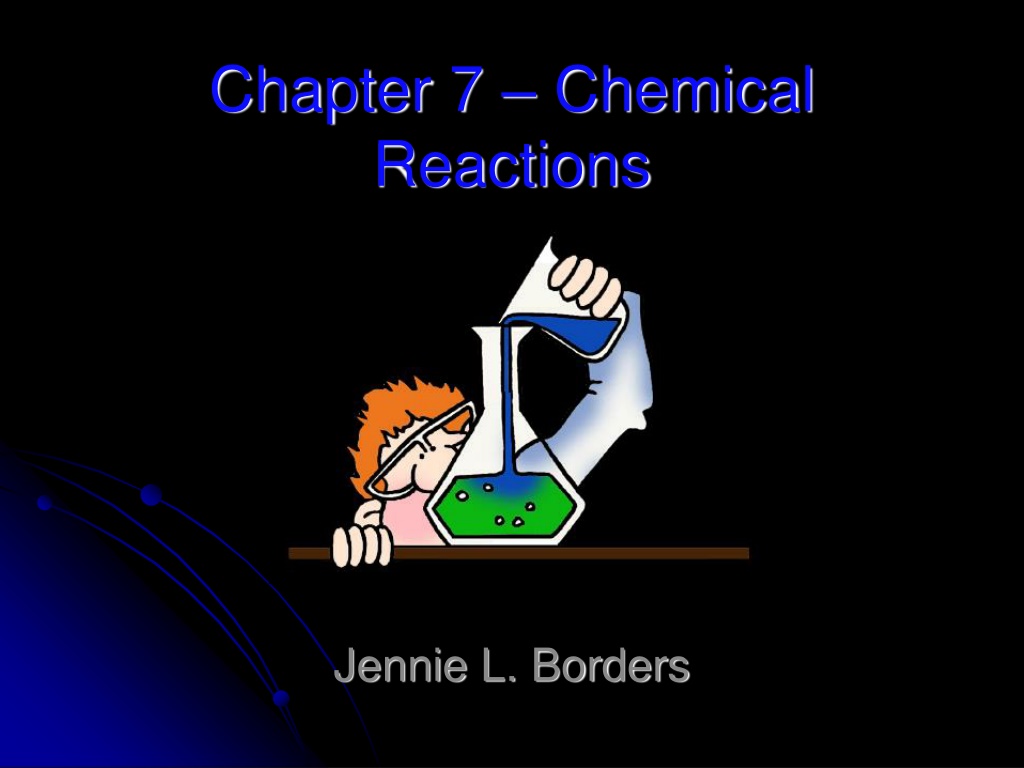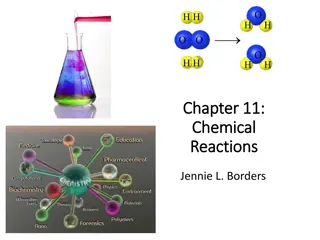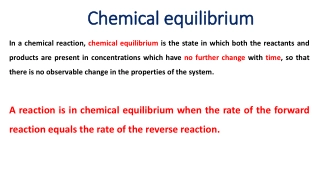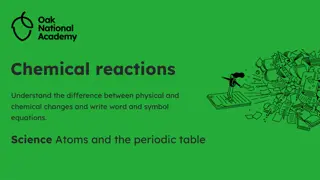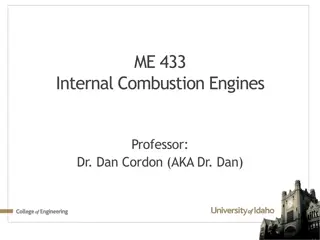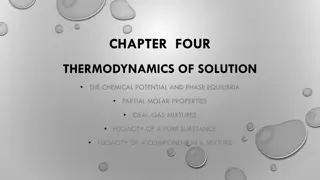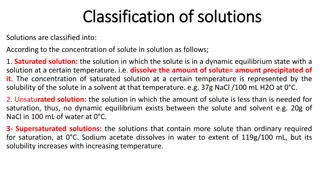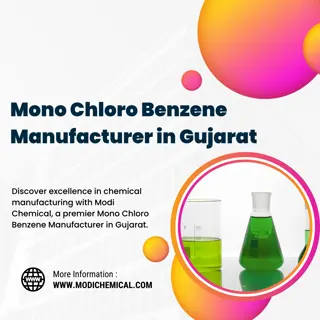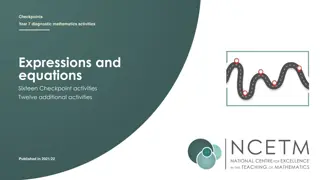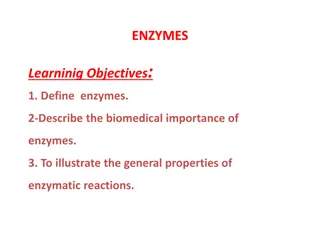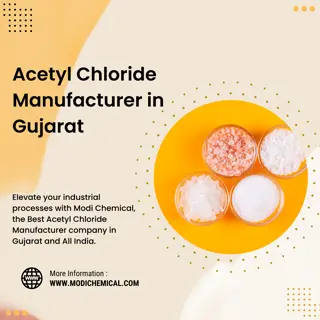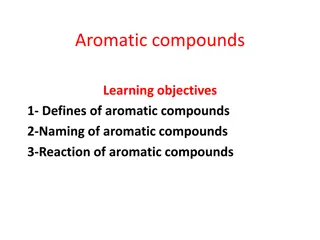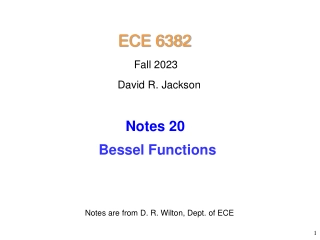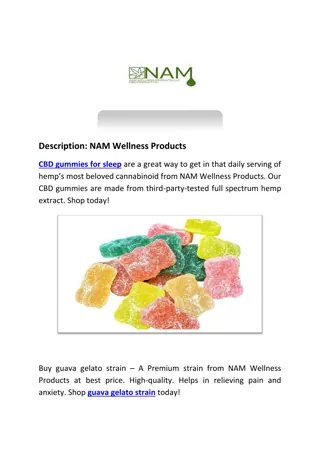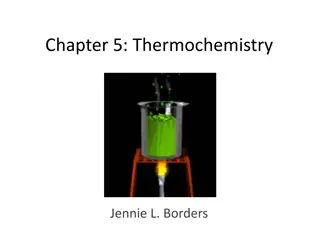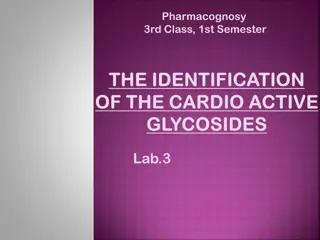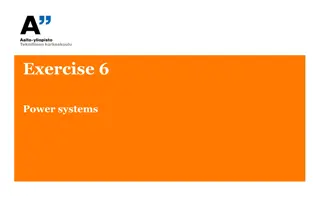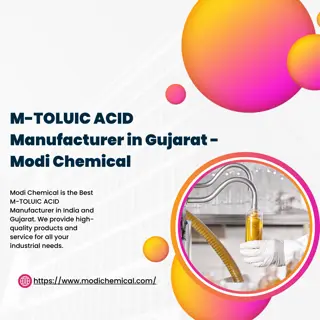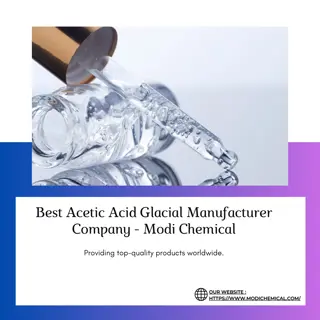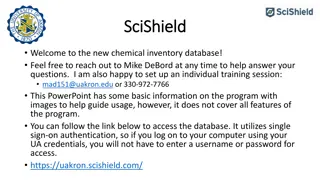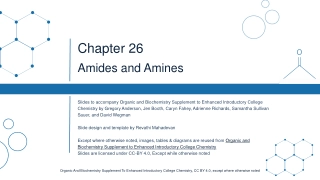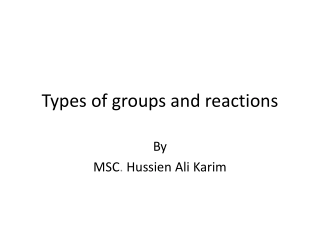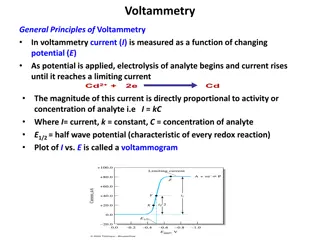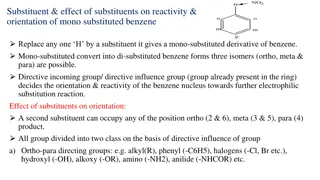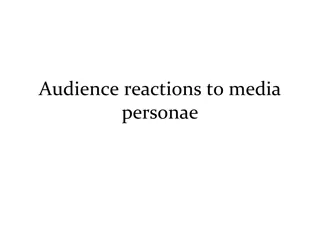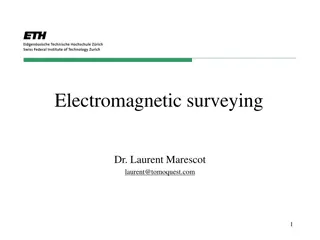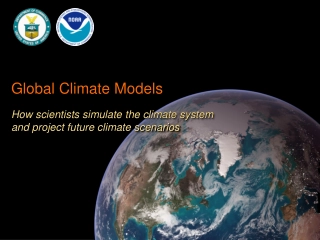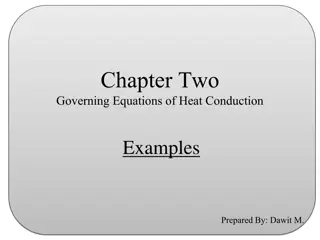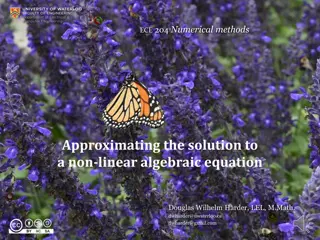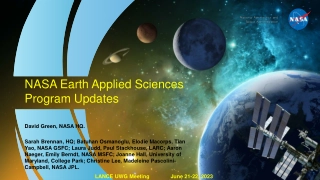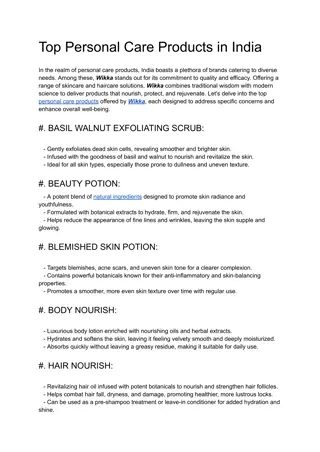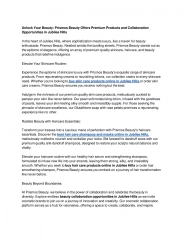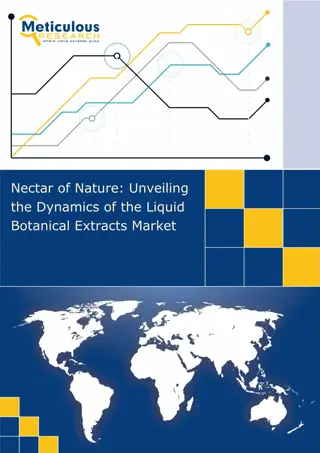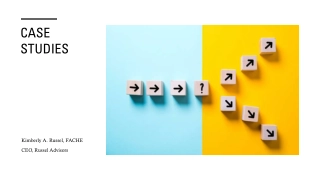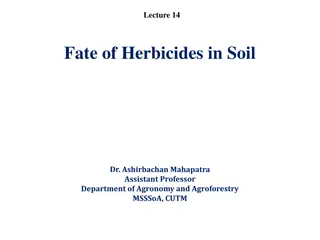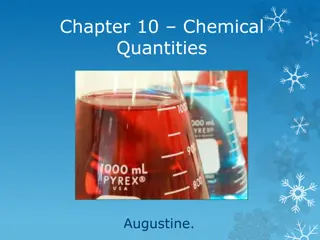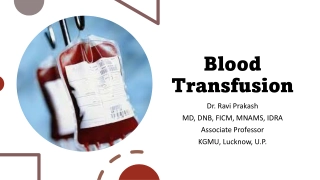Understanding Chemical Reactions: Reactants, Products, and Balancing Equations
Chemical reactions involve reactants that transform into products. Balancing equations is essential to ensure the conservation of mass. Learn about decomposition reactions, chemical equations, and methods to balance equations effectively.
Understanding Chemical Reactions: Reactants, Products, and Balancing Equations
PowerPoint presentation about 'Understanding Chemical Reactions: Reactants, Products, and Balancing Equations'. This presentation describes the topic on Chemical reactions involve reactants that transform into products. Balancing equations is essential to ensure the conservation of mass. Learn about decomposition reactions, chemical equations, and methods to balance equations effectively.. Download this presentation absolutely free.
Presentation Transcript
Chapter 7 Chemical Reactions Jennie L. Borders
Warm-Up Mar. 21 1. In a chemical reaction, what are the substances to the left of the arrow called? 2. When balancing equations, which numbers are you allowed to add? 3. What is a decomposition reaction?
Section 7.1 Describing Reactions In a chemical reaction, the substances that undergo change are called reactants. The new substances formed as a result of that change are called products. Reactants Products
Chemical Equations A chemical equation is a representation of a chemical reaction in which the reactants and products are expressed in formulas. The law of conservation of mass states that mass is neither created nor destroyed in a chemical reaction.
Balancing Equations In order to show that mass is conserved during a reaction, a chemical equation must be balanced. You can balance a chemical equation by changing the coefficients, the numbers that appear before the formulas. As you balance equations, you should never change the subscripts in a formula.
Balancing Equations Balance the following equations. Cu + O2 CuO 2Cu + O2 2CuO H2 + Cl2 2HCl H2 + Cl2 HCl H2O2 H2O + O2 2H2O2 2H2O + O2
Balancing Equations Balance the following equations. Mg + HCl H2 + MgCl2 Mg + 2HCl H2 + MgCl2 C2H4 + O2 CO2 + H2O C2H4 + 3O2 2CO2 + 2H2O
Hints for Balancing Equations Balance hydrogen and oxygen last. Keep polyatomic ions together if possible. If you have an odd number of atoms on one side, you can multiply by 2 to make it even.
Moles Because chemical reactions often involve large numbers of small particles, chemists use a counting unit called the mole to measure amounts of substances. 1 mole = 6.02 x 1023 particles This number is called Avogadro s number.
Section 7.1 Assessment 1. What is the law of conservation of mass? 2. Why does a chemical equation need to be balanced? 3. Why do chemists use the mole as a counting unit? 4. Is the following equation balanced? 2Na + Cl2 2NaCl SKIP!
Section 7.1 Assessment 5. Balance the following equation. K + Br2 KBr 6. Balance the following equation. Mg + O2 MgO
Warm-Up Mar. 25 1. Balance the following equation: Na + O2 Na2O 1. What is the law of conservation of mass? 2. What elements should you save until the end when balancing?
Section 7.2 Types of Reactions Some general types of chemical reactions are synthesis reactions, decomposition reactions, single-replacement reactions, double-replacement reactions, and combustion reactions.
Synthesis A synthesis reaction is a reaction in which two or more substances react to form a single substance. A + B AB 2Na + Cl2 2NaCl 2H2 + O2 2H2O
Decomposition A decomposition reaction is a reaction in which a compound breaks down into two or more simpler substances. AB A + B HgO Hg + O2 CaCO3 CaO + CO2
Single Replacement A single-replacement reaction is a reaction in which one element takes the place of another element in a compound. A + BC B + AC Cu + 2AgNO3 2Ag + Cu(NO3)2 2K + 2H2O H2 + 2KOH
Double Replacement A double-replacement reaction is one in which two different compounds exchange positive ions and form two new compounds. AB + CD AD + CB Pb(NO3)2 + 2KI PbI2 + 2KNO3 CaCO3 + 2HCl CaCl2 + H2CO3
Combustion A combustion reaction is one in which a substance reacts rapidly with oxygen, often producing heat and light. CxHy + O2 CO2 + H2O CH4 + 2O2 CO2 + 2H2O C6H12O6 + 6O2 6CO2 + 6H2O
Section 7.2 Assessment 1. What are five general types of reactions? 2. The synthesis of water is described by the following reaction 2H2 + O2 2H2O. How is the decomposition of water related to this reaction? 3. Explain the difference between a single- replacement reaction and a double- replacement reaction.
Section 7.2 Assessment 4. When propane (C3H8) undergoes combustion, what products are formed? 5. Identify the following reactions. a. Pb(NO3)2 + 2HCl PbCl2 + 2HNO3 b. 2C2H6 + 7O2 4CO2 + 6H2O c. Ca + 2HCl CaCl2 + H2 d. 2SO2 + O2 2SO3
Warm-Up Mar. 26 1. How many reactants are in a decomposition reaction? 2. What 3 elements will you see in a combustion reaction? 3. What type is the following reaction? 2Zn + Li2O Li + 2ZnO
Section 7.3 Energy Changes in Reactions Chemical energy is the energy stored in the chemical bonds of a substance. Chemical reactions involve the breaking of chemical bonds in the reactants and the formation of chemical bonds in the products.
Breaking and Forming Bonds Breaking chemical bonds requires energy. The formation of chemical bonds releases energy.
Energy in Chemical Reactions In a chemical reaction, energy is either released or absorbed.
Exothermic Reactions A chemical reaction that releases energy to its surroundings is called an exothermic reaction. In exothermic reactions, the energy released as the products form is greater than the energy required to break the bonds in the reactants. SKIP!
Endothermic Reactions A chemical reaction that absorbs energy from its surroundings is called an endothermic reaction. In an endothermic reaction, more energy is required to break the bonds in the reactants than is released by the formation of the products. SKIP!
Law of Conservation of Energy The law of conservation of energy states that energy is neither created nor destroyed in a chemical or physical process.
Section 7.3 Assessment 1. What happens to chemical bonds as a chemical reaction occurs? 2. How do chemical reactions involve energy? 3. Is the combustion of propane endothermic or exothermic? 4. Is energy created during an exothermic reaction? Explain.
Section 7.3 Assessment 5. What bonds are broken when one molecule of methane reacts with two molecules of oxygen in the following reaction: CH4 + 2O2 CO2 + 2H2O
Section 7.4 Reaction Rates A reaction rate is the rate at which reactants change into products over time. Reaction rates tell how fast a reaction is going.
Factors Affecting Reaction Rates Factors that affect reaction rates include temperature, surface area, concentration, stirring, and catalysts. Chemical reactions are based on the collisions of particles.
Temperature Generally, an increase in temperature will increase the reaction rate, while a decrease in temperature will decrease the reaction rate. Increasing the temperature of a substance causes its particles to move faster which causes more collisions.
Surface Area An increase in surface area increases the exposure of reactants to one another. The greater this exposure, the more collisions there are that involve reacting particles.
Stirring Stirring the reactants will generally increase the reaction rate. Stirring causes the reactants to combine quickly, which causes more collisions.
Concentration Concentration refers to the number of particles in a given volume. Generally, reaction rate increases as concentration increases. The more particles that are present in a given volume, the more opportunities there are for collisions involving those particles.
Catalysts A catalyst is a substance that affects the reaction rate without being used up in the reaction. Since a catalyst is neither a reactant nor a product, it is written over the arrow. V2O5 2SO2 + O2 2SO3
Section 7.4 Assessment 1. What does a reaction rate tell you? 2. What five factors affect reaction rate? 3. Explain why reactions take place faster at higher temperatures. 4. How does a catalyst make a reaction go faster?
Section 7.4 Assessment 5. Explain why hamburger meat lasts longer in the freezer than in refrigerator. 6. The reaction between magnesium and hydrochloric acid produces hydrogen. If you increase the concentration of HCl, the reaction takes place faster. Could HCl be considered a catalyst for this reaction? Explain.
